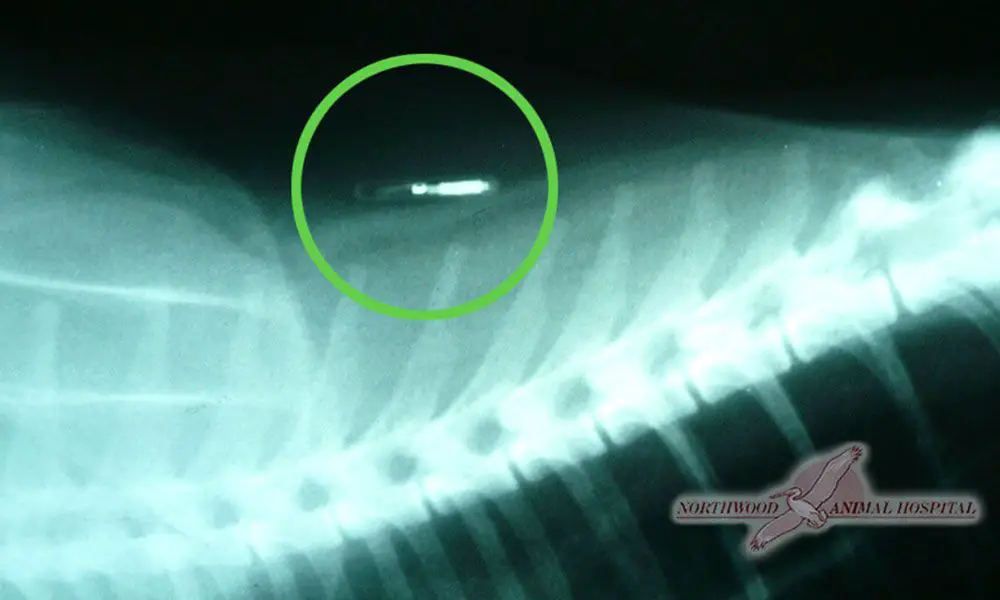What Are Cat Microchips?
A microchip is a small transponder implanted under a cat’s skin, usually between the shoulder blades. The microchip contains an identification number that can be read with a special scanner (Southseattlevet.com, 2019).
The microchip itself is about the size of a grain of rice and is implanted with a needle. It’s designed to last for the lifetime of a cat. The microchip is inert and doesn’t have a battery or any moving parts. It also doesn’t enable tracking of the cat’s location or movements.
![]()
The main purpose of cat microchips is to provide permanent identification if a cat is lost or separated from its owner. Shelters and veterinary clinics routinely scan strays for microchips to identify lost cats and reunite them with their owners.
Do Cat Microchips Have GPS?
Cat microchips do not contain GPS technology. They only store a unique ID number that can be scanned if the cat is lost or brought to an animal shelter. When the microchip is scanned, it provides the registered owner’s contact information so the cat can be reunited with its family.
GPS technology relies on satellites and cellular networks to pinpoint locations. This would require more complex technology and larger batteries than what can fit in a tiny microchip. Cat microchips are passive RFID (radio-frequency identification) chips that do not broadcast any location data.
When a microchipped cat is lost, the microchip itself does not provide any help locating where the cat is. Having an ID number stored in the microchip allows shelters to contact the owner when a lost cat is brought in. But the microchip does not have any GPS or tracking capabilities to find lost cats.
While microchips are still highly recommended to improve lost pet reunification, pet owners who want to actively track their cat’s location need a GPS cat collar or other GPS tracking device. Microchips themselves only provide permanent ID and contact information.

Sources:
https://www.aliexpress.com/w/wholesale-microchips-for-cats-with-gps.html
Benefits of Microchipping Cats
Microchipping cats provides several important benefits for cat owners. The primary benefit is that it helps identify lost cats and reunite them with their owners. When a microchipped cat ends up at an animal shelter or vet clinic, the staff can scan the chip to get the owner’s contact information and notify them that their cat has been found. This prevents lost cats from being adopted by someone else or euthanized at a shelter. According to the American Humane Society, over 90% of microchipped lost pets are returned to their owners.
Microchipping also helps reduce the number of stray and feral cats. Unclaimed stray cats are a major contributor to cat overpopulation and euthanasia rates in shelters. When a stray cat is scanned and has no microchip or registration, there is no way to find potential owners. Microchipping cats provides permanent identification and makes it far more likely for a lost cat to be returned home rather than become part of the stray population.
Some additional benefits of microchipping cats include providing proof of ownership, avoiding disputes over lost or stolen cats, and allowing for easy identification if a cat is injured or killed in an accident. Overall, a microchip greatly increases the chances of a lost or stolen cat safely returning home.
Microchip Scanner
A cat’s microchip is read using a handheld scanner device passed over the implantation site. The scanner emits a low radio frequency that activates the microchip if it’s present. The microchip then transmits its unique identification number back to the scanner, which displays the ID on its screen (How to Scan a Cat for a Microchip, https://www.alleycat.org/resources/how-to-scan-a-cat-for-a-microchip/).
To scan for a microchip, start at the cat’s shoulders and move the scanner back and forth slowly in an S-shaped pattern. Scan along the cat’s sides and down the legs to the paws. Make sure to scan both sides thoroughly. If no chip is detected after 10 seconds, the cat likely does not have one (How to Scan a Microchip in Your Vet Practice, https://www.akcreunite.org/oldveterinarians/scanvets/).
Scanners are available from veterinary clinics, animal shelters, and pet stores. There are also smartphone apps that can scan microchips if you have an NFC-enabled phone. DIY microchip scanners for home use are also available to purchase online.
Microchip Registration
After a microchip is implanted in a cat, it needs to be registered along with the owner’s contact information in a pet database. This is a crucial step, as the microchip itself does not contain any identifying information. The microchip is essentially just a unique ID number that can be scanned if the cat is lost. When the microchip is scanned by a vet or shelter, they can look up the ID number in the database and access the owner’s contact details to reunite the lost cat with its owner.
Some of the top pet microchip registries in the UK include Petlog, Pet ID Microchips, and Anibase. These registries allow owners to quickly register their details via an online form or over the phone [1]. The owner’s information stored in the database includes their name, address, phone number, and email. Some registries also allow uploading a photo of the cat and noting any special medical needs or behavioral quirks to aid in identification.
It is essential for cat owners to keep their contact information up-to-date in the microchip registry they used. If any details like an address or phone number change, owners can easily log in to their registry account and update it so they can still be reached if their cat is lost [2]. Overall, properly registering a cat’s microchip provides the best chance for lost pets to be returned to their owners.

Alternatives to Microchips
While microchipping is the most secure form of pet identification, there are some alternatives pet owners can consider:
Collars with ID tags – Collars with engraved ID tags are a simple way to provide your contact information. However, collars and tags can easily fall off or get lost. They also don’t provide permanent identification like a microchip does.
Tattooing inside the ear – Tattooing involves putting an ID number inside your cat’s ear. This provides permanent identification, but doesn’t store as much information as a microchip. The tattoo must also be large enough for people to easily read it when a pet is found.[1]
Ultimately, microchipping provides the most secure and convenient form of identification that can’t fall off or get lost. But collars and tattoos can be good secondary forms of ID.
Microchipping Procedure
The microchipping procedure for cats is quick and simple. The microchip is injected under the skin between the shoulder blades using a syringe. It’s no more invasive than a routine vaccination. The entire process takes just a few seconds.
Veterinarians will often use a local anesthetic to numb the area before injecting the microchip. This helps minimize any discomfort for the cat. Though the needle used is larger than for a typical vaccine, the microchip itself is tiny, around the size of a grain of rice.
Unlike some medical procedures, microchipping a cat does not require any stitches. The needle puncture seals quickly on its own. After the injection, the only evidence of the microchip will be the unique ID number registered in the microchip company’s database.
Overall, microchipping is a fast and easy way to identify cats. It causes minimal stress and discomfort for feline friends. While the process does involve a quick injection, the benefits of being able to reunite lost pets with their owners greatly outweighs this small moment of pain.
Microchip Safety
Microchipping cats and other pets is considered extremely safe and complication rates are very low. The microchip itself is inert and poses essentially no health risks to cats. The microchips are made of a biocompatible material that does not cause any inflammation or rejection when properly inserted under the skin. The implantation procedure is minimally invasive and rarely has any side effects beyond mild soreness at the injection site.
According to veterinary experts, cat microchips are non-toxic and contain no power source, so they do not emit any kind of frequency or electrical output. They are simply small identifying devices encased in inert glass. Some studies have shown no association between microchipping and increased incidence of cancer in pets. Overall, the complication rate is around 1-3% for minor issues like failed scans, chip migration or improper implantation. Serious issues like tumor formation or infection are extremely rare at rates under 0.1%.
In summary, microchips are very safe for cats, with minimal risks from the procedure and essentially no long-term health effects from the implanted device itself. Pet owners can feel confident that microchipping provides significant benefits for cat identification and recovery with very little downside in terms of safety (source, source).
Microchip Cost
Getting your cat microchipped is an affordable way to provide permanent identification. The cost for microchipping a cat typically ranges from $25 to $50 if done through your veterinarian. Some veterinary clinics include microchipping for free when you adopt a cat or kitten from them.
Many animal shelters and humane societies offer low-cost microchipping clinics that allow pet owners to get their cats chipped for less. These clinics often charge around $20-30 for the microchip procedure. You can also find discounted or free microchipping events in some communities.
The microchip itself is relatively inexpensive, usually $5-15. The bulk of the cost goes towards the insertion by the veterinarian or technician. So taking advantage of a low-cost microchipping clinic can save you quite a bit over getting it done through a private vet.
While the upfront cost seems minimal, getting your cat microchipped is an investment in their safety that can provide peace of mind for years to come. It’s a simple procedure that could make a huge difference if your cat ever becomes lost.
(Source: https://www.goodrx.com/pet-health/cat/microchip-cost)
GPS Cat Collars
While microchips themselves do not contain GPS, there are GPS tracking collars available for cats that allow owners to pinpoint their location. GPS cat collars contain a small GPS module that tracks the cat’s whereabouts via satellite and transmits the location data to the owner’s smartphone or computer [1]. Some popular options include Whistle, Tractive, and Pawfit [2].
![]()
GPS collars can provide peace of mind for owners of cats that go outdoors and tend to roam and explore. However, there are some limitations. The collars require charging regularly, may not work well indoors, and some cats may not tolerate wearing a collar. They are also an added expense compared to a standard microchip. While useful for tracking in real-time, GPS collars serve a different purpose than microchips, which provide permanent pet identification and a way to reunite lost pets with their owners [3].

